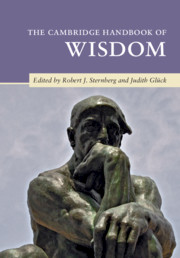Book contents
- The Cambridge Handbook of Wisdom
- The Cambridge Handbook of Wisdom
- Copyright page
- Dedication
- Contents
- Figures
- Tables
- Contributors
- Preface
- Part I Foundations of Wisdom
- Part II Conceptions of Wisdom
- Part III Measures of Wisdom
- Part IV The Development of Wisdom
- Part V Cultural Perspectives on Wisdom
- Part VI Wisdom and Other Psychological Constructs
- 20 Creativity, Intelligence, and Wisdom
- 21 Giftedness and Wisdom
- 22 Low Levels of Wisdom
- 23 The Mirror of Wisdom
- 24 Identity and Purpose in Life As Building Blocks for Wisdom
- 25 Wisdom, Morality, and Ethics
- 26 Wisdom and Emotion
- 27 Wisdom and Well-Being
- 28 Relationship between Wisdom and Spirituality
- Part VII Wisdom in Action
- Part VIII Conclusions
- Index
- References
20 - Creativity, Intelligence, and Wisdom
Could versus Should
from Part VI - Wisdom and Other Psychological Constructs
Published online by Cambridge University Press: 15 March 2019
- The Cambridge Handbook of Wisdom
- The Cambridge Handbook of Wisdom
- Copyright page
- Dedication
- Contents
- Figures
- Tables
- Contributors
- Preface
- Part I Foundations of Wisdom
- Part II Conceptions of Wisdom
- Part III Measures of Wisdom
- Part IV The Development of Wisdom
- Part V Cultural Perspectives on Wisdom
- Part VI Wisdom and Other Psychological Constructs
- 20 Creativity, Intelligence, and Wisdom
- 21 Giftedness and Wisdom
- 22 Low Levels of Wisdom
- 23 The Mirror of Wisdom
- 24 Identity and Purpose in Life As Building Blocks for Wisdom
- 25 Wisdom, Morality, and Ethics
- 26 Wisdom and Emotion
- 27 Wisdom and Well-Being
- 28 Relationship between Wisdom and Spirituality
- Part VII Wisdom in Action
- Part VIII Conclusions
- Index
- References
Summary
- Type
- Chapter
- Information
- The Cambridge Handbook of Wisdom , pp. 455 - 464Publisher: Cambridge University PressPrint publication year: 2019
References
- 7
- Cited by



